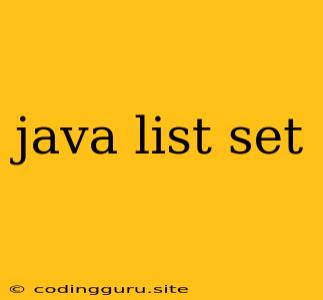Understanding Java's List and Set: A Comprehensive Guide
In the world of Java programming, collections play a crucial role in managing and organizing data. Two fundamental collections, List and Set, are essential tools for developers. While both serve as containers for objects, their unique characteristics and functionalities make them distinct choices for specific scenarios.
What is a List in Java?
Imagine a shopping list where you need to keep track of the items you want to purchase, and their order matters. This is analogous to a List in Java. It allows you to store an ordered collection of elements, enabling access by index and maintaining insertion order.
Key Properties of a List:
- Ordered: Elements are stored in the order they were added.
- Duplicates Allowed: You can have multiple occurrences of the same element in a List.
- Indexed Access: You can access elements directly by their index (starting from 0).
Common List Implementations in Java:
- ArrayList: A resizable array-based implementation, efficient for random access and insertion/deletion at the end.
- LinkedList: A linked list implementation, efficient for insertion/deletion at any position.
- Vector: A thread-safe, synchronized version of ArrayList.
- Stack: A LIFO (Last-In, First-Out) data structure, ideal for scenarios requiring element retrieval in reverse order.
When to Use a List:
- When the order of elements is important.
- When you need to access elements by index.
- When you need to allow duplicate elements.
Examples of Using List:
import java.util.ArrayList;
import java.util.List;
public class ListExample {
public static void main(String[] args) {
List shoppingList = new ArrayList<>();
// Adding elements
shoppingList.add("Milk");
shoppingList.add("Eggs");
shoppingList.add("Bread");
shoppingList.add("Cheese");
// Accessing elements
System.out.println("First item: " + shoppingList.get(0));
// Iterating through the list
for (String item : shoppingList) {
System.out.println(item);
}
}
}
What is a Set in Java?
Imagine a collection of unique items, like a set of playing cards. You can only have one card of a particular kind in the set. This concept mirrors a Set in Java. It stores a collection of unique elements, disallowing duplicates.
Key Properties of a Set:
- Unordered: Elements are not stored in any particular order.
- No Duplicates: Only one instance of an element can exist in a Set.
- Hash-based: Sets often utilize hashing mechanisms for efficient element lookup.
Common Set Implementations in Java:
- HashSet: An implementation based on a hash table, providing fast element lookup and insertion.
- LinkedHashSet: An implementation that maintains insertion order, combining the efficiency of HashSet with the ordering benefits of a linked list.
- TreeSet: An implementation based on a binary search tree, offering sorted order and logarithmic search time.
When to Use a Set:
- When you need to store unique elements.
- When you need to perform fast element lookup.
- When you require sorted order (using TreeSet).
Examples of Using Set:
import java.util.HashSet;
import java.util.Set;
public class SetExample {
public static void main(String[] args) {
Set uniqueNumbers = new HashSet<>();
// Adding elements
uniqueNumbers.add("1");
uniqueNumbers.add("2");
uniqueNumbers.add("3");
// Trying to add a duplicate
uniqueNumbers.add("2"); // This will be ignored
// Iterating through the set
for (String number : uniqueNumbers) {
System.out.println(number);
}
}
}
Choosing Between List and Set:
The choice between a List and a Set hinges on your specific needs and priorities:
- List: Prioritize order, indexed access, and the ability to store duplicates.
- Set: Prioritize uniqueness, fast lookup, and potentially sorted order.
Conclusion:
Understanding the nuances of List and Set in Java is fundamental for any developer. Choosing the right collection type for your data will not only improve code readability and maintainability but also enhance the performance and efficiency of your Java applications.
